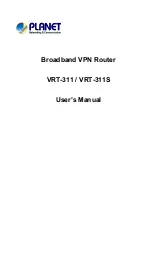
Configuring the Switch
3-172
3
•
Priority
– Bridge priority is used in selecting the root device, root port, and
designated port. The device with the highest priority becomes the STA root device.
However, if all devices have the same priority, the device with the lowest MAC
address will then become the root device. (Note that lower numeric values indicate
higher priority.)
- Default: 32768
- Range: 0-61440, in steps of 4096
- Options: 0, 4096, 8192, 12288, 16384, 20480, 24576, 28672, 32768, 36864,
40960, 45056, 49152, 53248, 57344, 61440
•
Spanning Tree BPDU Flooding
– Configures the system to flood BPDUs to all
other ports on the switch or just to all other ports in the same VLAN when spanning
tree is disabled globally on the switch or disabled on a specific port.
- To VLAN: Floods BPDUs to all other ports within the receiving port’s native
VLAN (i.e., as determined by port’s PVID). This is the default.
- To All: Floods BPDUs to all other ports on the switch.
The setting has no effect if BPDU flooding is disabled on a port (see “Configuring
Interface Settings” on page 3-178).
Root Device Configuration
•
Hello Time
– Interval (in seconds) at which the root device transmits a
configuration message.
- Default: 2
- Minimum: 1
- Maximum: The lower of 10 or [(Max. Message Age / 2) -1]
•
Maximum Age
– The maximum time (in seconds) a device can wait without
receiving a configuration message before attempting to reconfigure. All device
ports (except for designated ports) should receive configuration messages at
regular intervals. Any port that ages out STA information (provided in the last
configuration message) becomes the designated port for the attached LAN. If it is
a root port, a new root port is selected from among the device ports attached to the
network. (References to “ports” in this section mean “interfaces,” which includes
both ports and trunks.)
- Default: 20
- Minimum: The higher of 6 or [2 x (Hello Time + 1)].
- Maximum: The lower of 40 or [2 x (Forward Delay - 1)]
•
Forward Delay
– The maximum time (in seconds) this device will wait before
changing states (i.e., discarding to learning to forwarding). This delay is required
because every device must receive information about topology changes before it
starts to forward frames. In addition, each port needs time to listen for conflicting
information that would make it return to a discarding state; otherwise, temporary
data loops might result.
- Default: 15
- Minimum: The higher of 4 or [(Max. Message Age / 2) + 1]
- Maximum: 30
Summary of Contents for iES4028F
Page 1: ...iES4028F 4028FP 4024GP ...
Page 4: ...iv This page is intentionally left blank ...
Page 10: ...x This page is intentionally left blank ...
Page 28: ...Contents xxviii This page is intentionally left blank ...
Page 32: ...Tables xxxii This page is intentionally left blank ...
Page 46: ...Introduction 1 10 1 This page is intentionally left blank ...
Page 336: ...Configuring the Switch 3 280 3 This page is intentionally left blank ...
Page 688: ...Command Line Interface 4 352 4 This page is intentionally left blank ...
Page 702: ...Glossary Glossary 8 This page is intentionally left blank ...
Page 710: ...Index 8 Index This page is intentionally left blank ...
Page 711: ...This page is intentionally left blank ...
Page 712: ...iES4028F 4028FP 4024GP ...
















































